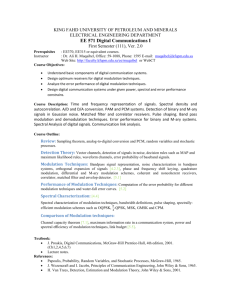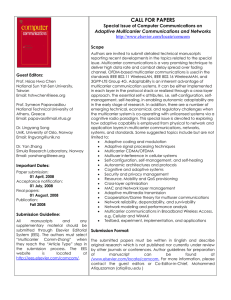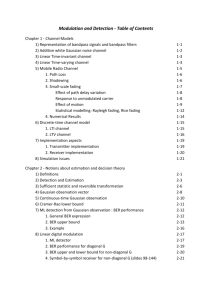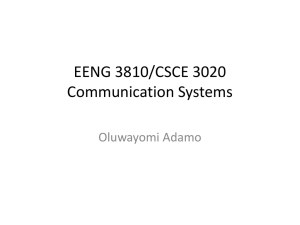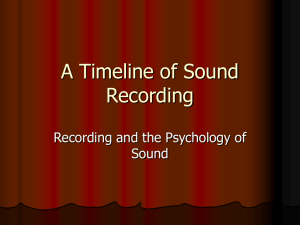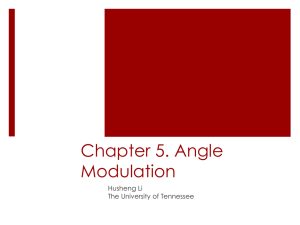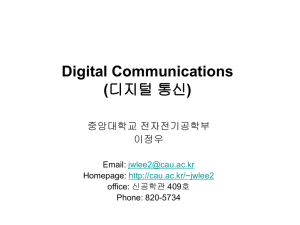Chapter 3 Digital Communication Fundamentals for Cognitive Radio
advertisement
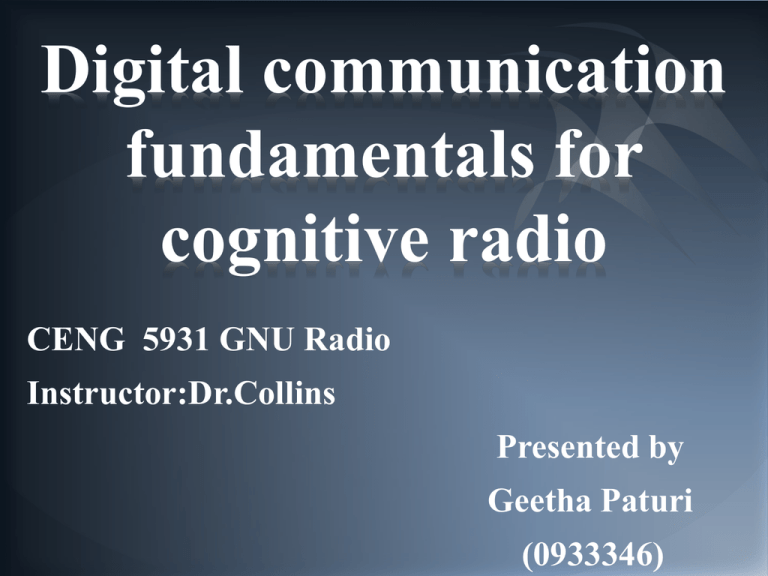
Digital communication fundamentals for cognitive radio CENG 5931 GNU Radio Instructor:Dr.Collins Presented by Geetha Paturi (0933346) Contents 1. Introduction 2. Digital Modulation techniques 3. Multicarrier Modulation 4. Advantages and disadvantages of multicarrier modulation 5. Comparison between single and multicarrier modulation 6. Multicarrier equalization techniques 7. Intersymbol interference 8. Pulse Shaping 9. Conclusion Introduction Data communication system (requirements) Robust to error Sufficient data rates Network capacity constraints Achieve balance between these requirements to overcome conflicting system operating parameters. Data Transmission (Anatomy of wireless digital communication system) Bit error rate(BER) Band width efficiency Fundamental limits: Shannon–Hartley theorem B:Transmission bandwidth C:Channel capacity(b/s) Sources of Transmission error: Noise into data transmission & effects of a band-limited transmitted medium. Digital Modulation Techniques Representation of Signals Euclidean Distance between Signals Decision Rule Power Efficiency M-ary Phase Shift Keying M-ary Quadrature Amplitude Modulation Representation of Signals Euclidean Distance between Signals From a signal constellation plot we can see how an error may occur in the transmission whenever the actually received signal vector is incorrectly shifted to another signal constellation point by noise contribution. Euclidean Distance and vector representation between two signals is defined as d ij 2 s ( t ) s i d ij s i s j ( t ) dt j 2 Decision Rule Nearest neighbor rule r si r s j , j i r si r s j , j i waveform representation T r (t ) s 0 T i ( t ) dt r (t ) s 0 j ( t ) dt Power Efficiency Power efficiency of modulation scheme measures the largest minimum signal distance achievable by modulation technique given the lowest transmit power available. Energy per symbol M 1 Es s i ( t )dt 2 P i0 i Energy per bit Eb Es log Power efficiency 2 M 2 P d min Eb M-ary Phase Shift Keying s i ( t ) A cos( c t 2 t m ), m 0 ,1, , M 1 M-ary Quadrature Amplitude Modulation Constellation map of 16 QAM QAM Receiver Multicarrier modulation Single input/Single output MCM transmitter Single input/Single output MCM receiver Advantages and disadvantages of Multicarrier modulation ADVANTAGES • Transmission agility • High data rate • Immunity to non-flat fading response. • “divide-and-conquer” channel distortion • Adaptive bit loading DISADVANTAGES • Sensitive to narrowband noise • Sensitive to amplitude clipping • Sensitive to timing jitter, delay Comparison between single carrier and multicarrier Multicarrier equalization techniques To improve quality of received signal equalizers are employed. Design decisions of equalizer depend on a number of factors such as type of distortion and implementation complexity. Distortion reduction To mitigate effects of distortion introduced by the channel there are two techniques. Channel coding-Adding redundancy Channel equalization-effects of channel are inverted at receiver Intersymbol Interference When transmissions are sent across a dispersive channel it is possible for the output of that channel intercepted by the receiver to be distorted via temporal spreading resulting in overlapping of individual symbol pulses. Pulse Shaping SOURCE IMPULSE MODULATION H(f)Pulse shaping filter To channel Conclusion Mathematical tools necessary for enabling advanced features Various modulation schemes can be used for transmission under different constraints and expectations Bit Error Rate is primarily used to define performance Digital communication theory at the core of cognitive radio operations References 1.“Cognitive radio communications and networks principles and practice” By A.M.Wyglinski,M.nekovee,Y.T.Hou(Elevier,December 2009) 2. Sklar, B.; , "Defining, designing, and evaluating digital communication systems ," Communications Magazine, IEEE , vol.31, no.11, pp.91-101, Nov 1993 doi: 10.1109/35.256888 3. Kolumban, G.; Kennedy, M.P.; Chua, L.O.; , "The role of synchronization in digital communications using chaos. I . Fundamentals of digital communications," Circuits and Systems I: Fundamental Theory and Applications, IEEE Transactions on , vol.44, no.10, pp.927-936, Oct 1997 doi: 10.1109/81.633882



